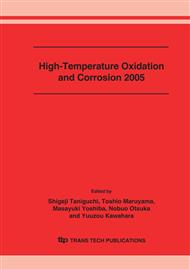p.523
p.531
p.539
p.547
p.555
p.563
p.571
p.581
p.589
Effect of Alloying Elements on Corrosion Resistance of Ni-Base Cast Alloys in Waste Incineration Environments
Abstract:
After examining practical structural materials for use in the high-temperature environments of waste incinerators, it was found that a Ni-Cr-W casting alloy is promising. However, the corrosion reaches its peak in the vicinity of 900°C. This peak is related to the behavior of chlorides that form in the interior of the alloy. As the chlorides continuously generate and decompose, the Cl recycles, accelerating corrosion. It is thought that when the temperature rises, the chlorides vaporize outside the alloy, suppressing Cl recycling and thus reducing the amount of corrosion. Adding Al to the alloy generates highly volatile AlCl3, making it possible to prevent the accumulation of chlorides in the vicinity of 900°C and lower the corrosion peak. As a result of conducting exposure testing for a year at an actual incinerator, it was demonstrated that adding Al is an effective way to improve corrosion resistance.
Info:
Periodical:
Pages:
555-562
Citation:
Online since:
August 2006
Price:
Сopyright:
© 2006 Trans Tech Publications Ltd. All Rights Reserved
Share:
Citation:


